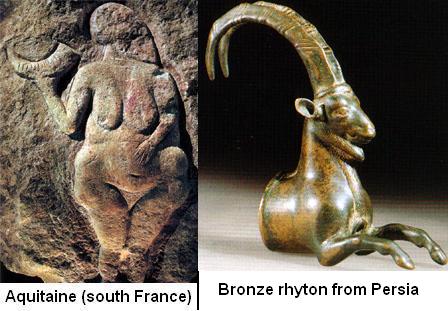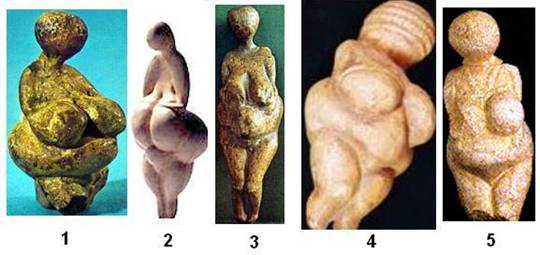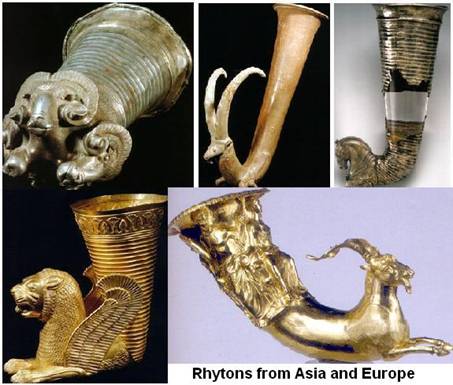|
The Asiatic Uighur tribes who spread to the four corners of
the world considered the ibex as their sacred totem animal
(see Chapter 3). The culture of these ancient nomadic tribes
was based on oral traditions and their method of communication
was essentially synthetic and pictographic. They prayed and
made offerings to the sun-god, which was their most important
deity. During these rituals the hollow horn of the ibex was
used as a cup for solemn promises. It was also used to make an
oath. The etymology of “oath” is known to be
ǎth
in old English but, most probably, its original form was
Octh, a promise of
solidarity to the Okh
leader.

The
naked woman above is holding a curved ibex horn in her right
hand. The wall relief is in the south-west part of France,
known as Aquitaine. This region was part of the Occitania and
is known as
Aquitania
in Occitan and
Akitania in Basque
(see Chapter 2, The
Proto-language of
Central Asia).
The initial phonemes of these names (Aq
and Ak) are
possible relics of the ancient
Oc nation. On the
right we see a bronze rhyton in the form of an ibex from
Persia (1).
An
interesting point to note is that there are no facial details
on the wall relief above. This was done on purpose, the reason
being that she was the human representation of the sun deity.
The sun rays were imagined to come out from small holes on the
surface of the sun. This is why ancient cultures made small
holes on the head of sun-goddess figurines without showing the
facial details. Some examples are shown below.
All of them are about 10cm tall or less, an indication that
they are sacred amulets of the sun-goddess. As mentioned above
none of them have facial details. The exact date of these
amulets is not precisely determined but they are estimated to
be minimum 5,000 years or more ancient. Since most of these
mother goddesses were found in the north of the Black Sea
(within present Russia and Ukraine) and Central Europe, we can
safely guess that the sun cult originated from central Asia
where ibexes and shaman woman were considered as
representation of the sun deity
(2).

1.
Gagarino (Ukraine),
2.
Lespuges (France),
3.
Kostenki (Russia),
4.
Willendorf (Austria),
5.
Kostenki (Russia)
Another strong indication about the
origin of the sacred horn is obtained when the ancient rhytons
are investigated. Some examples of rhytons are shown below. We
see that not only the horned animals but also lions and horses
were considered to be sacred.
(3)

Horses had a special place in the culture of Asiatic nomadic
tribes. Horses were the main vehicle of transport and a person
without a horse was not considered to be important. An ancient
Turkish saying can be translated as: “The one without a horse
cannot have a name”. The original form of this sentence has
the rhyming words “at”
(horse) and “ad”
(name). I have already mentioned that “ata”
means ancestor in Turkish (see chapter 11,
The Eastern expansion).
It is due to the horse that during the Neolithic period (about
10,000 years BP) people migrated very rapidly towards the west
and south-west of Central Asia, spreading their culture and
language, which is the common mother tongue from which all
European languages derived. |